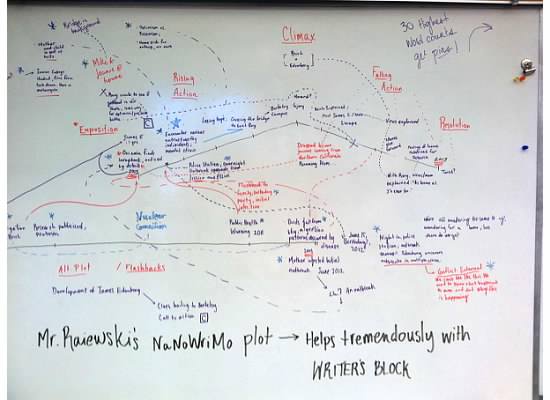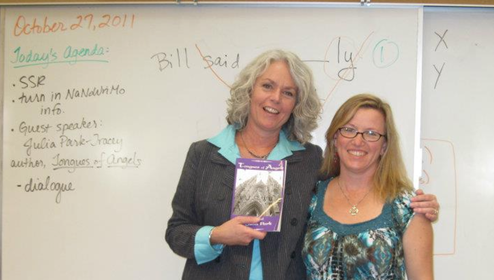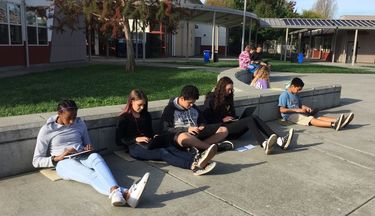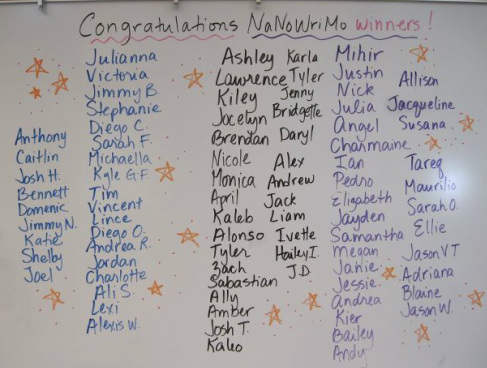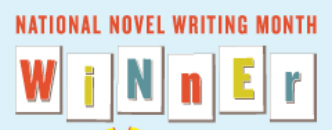A day in the life of a NaNo classroom

August - October:
Prior to the November launch of NaNoWriMo, we take time to brainstorm, plot, and plan as many details as we can for our novels. The YWP workbooks (available free for elementary, middle, and high schoolers) are invaluable resources for getting our creative juices flowing and organizing our ideas before we start writing. Classwork and homework is dedicated to:
Prior to the November launch of NaNoWriMo, we take time to brainstorm, plot, and plan as many details as we can for our novels. The YWP workbooks (available free for elementary, middle, and high schoolers) are invaluable resources for getting our creative juices flowing and organizing our ideas before we start writing. Classwork and homework is dedicated to:
- genre
- characters
- conflicts
- settings
- plots
- resolutions
- dialogue
Teachers write, too:
A valuable part of the writing process is for students to see their teachers struggling along with them. I like to share my writing with my students, asking them for help when I'm stuck. My next-door neighbor teacher even mapped out his novel on the whiteboard, sharing the process with his students and letting them see how he made revisions throughout the month:
A valuable part of the writing process is for students to see their teachers struggling along with them. I like to share my writing with my students, asking them for help when I'm stuck. My next-door neighbor teacher even mapped out his novel on the whiteboard, sharing the process with his students and letting them see how he made revisions throughout the month:
Author inspiration:
We have also invited local authors to visit our classroom and share some novel-writing secrets. Two authors brought excerpts from their novels to illustrate the concepts:
We have also invited local authors to visit our classroom and share some novel-writing secrets. Two authors brought excerpts from their novels to illustrate the concepts:
- Julia Park-Tracey (Tongues of Angels; Veronica Layne series; The Doris Diaries series) taught us how to craft effective dialogue.
- Susan Farren (The Fireman's Wife) shared strategies for creating meaningful settings in our novels.
Word count goals:
Since YWP lets students choose their own word goals, students need to get a sense of how many words will be appropriate for them. Since the first question asked when assigned a piece of writing is, "How long does it have to be?" I recommend tackling the word goal lesson early on.
I give my students a huge list of writing topics and have them write in a Google Doc on any topic they want for ten minutes. Then I show them how to check their word total (Tools > Word Count), which they multiply by six to see how many words they might write in an hour, and then calculate the words they could write if they wrote for an hour a day, every day, in November. This helps them choose a challenging but appropriate goal for themselves. Check out these recommended word goals by grade level.
How to start chapter one:
Near the end of October, in anticipation of starting our novels, I give a lesson on creating an "inciting incident" for chapter one. The students love looking back at how their favorite authors grabbed their attention in the opening chapters of their novels, and the examples give them ideas for their opening chapters. You are welcome to share my presentation with your students:
Since YWP lets students choose their own word goals, students need to get a sense of how many words will be appropriate for them. Since the first question asked when assigned a piece of writing is, "How long does it have to be?" I recommend tackling the word goal lesson early on.
I give my students a huge list of writing topics and have them write in a Google Doc on any topic they want for ten minutes. Then I show them how to check their word total (Tools > Word Count), which they multiply by six to see how many words they might write in an hour, and then calculate the words they could write if they wrote for an hour a day, every day, in November. This helps them choose a challenging but appropriate goal for themselves. Check out these recommended word goals by grade level.
How to start chapter one:
Near the end of October, in anticipation of starting our novels, I give a lesson on creating an "inciting incident" for chapter one. The students love looking back at how their favorite authors grabbed their attention in the opening chapters of their novels, and the examples give them ideas for their opening chapters. You are welcome to share my presentation with your students:
November:
Day 1 of November is a "ready, set, start writing NOW" day! Students have their planning workbooks on their desks, and their chapter 1/page 1 ideas ready to go. I let them plug in to music so they can concentrate on their writing without being distracted by the tap-tap-tapping of writers around them. And - lo and behold - they all write furiously for a good 30 minutes! We take a stretch break and chat about how it's going, and then we get quiet and write for another half hour.
A typical class period:
Every class day in November, students are given most of the period to write. We start with a mini-lesson, such as how to:
Day 1 of November is a "ready, set, start writing NOW" day! Students have their planning workbooks on their desks, and their chapter 1/page 1 ideas ready to go. I let them plug in to music so they can concentrate on their writing without being distracted by the tap-tap-tapping of writers around them. And - lo and behold - they all write furiously for a good 30 minutes! We take a stretch break and chat about how it's going, and then we get quiet and write for another half hour.
A typical class period:
Every class day in November, students are given most of the period to write. We start with a mini-lesson, such as how to:
|
YouTube and the YWP site provide great videos and writers' advice for these lessons. I even made my own writing-tip-video when I was away at a conference during NaNoWriMo:
After our mini-lesson, we settle into our writing and off we go... (Check out this post for more on the daily agenda.)
November 30:
When we come back from Thanksgiving break, we're in the home stretch. We write every day in class, interrupting our silence only when someone meets their goal. Then we all cheer, watch the "congrats" video from NaNoWriMo, and get back to work so we can all be winners.
November 30:
When we come back from Thanksgiving break, we're in the home stretch. We write every day in class, interrupting our silence only when someone meets their goal. Then we all cheer, watch the "congrats" video from NaNoWriMo, and get back to work so we can all be winners.
Post-NaNoWriMo:
Once November ends, I have my students set aside their novel drafts until the new year. There are lots of NaNo-related activities we can do in December, and they are always surprised by (and proud of) their writing when they revisit it a month later.
My Wri-Mos know that meeting their goal isn't the same as finishing their novel. So, although NaNoWriMo is officially over and we have to move on to other curriculum, we try to carve out time to continue to work on our stories and get them ready for publication.
Once November ends, I have my students set aside their novel drafts until the new year. There are lots of NaNo-related activities we can do in December, and they are always surprised by (and proud of) their writing when they revisit it a month later.
My Wri-Mos know that meeting their goal isn't the same as finishing their novel. So, although NaNoWriMo is officially over and we have to move on to other curriculum, we try to carve out time to continue to work on our stories and get them ready for publication.
